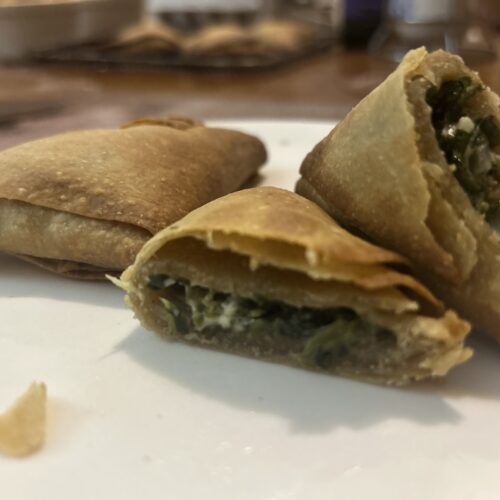
Fresh Milled Phyllo Dough
Light, flaky sheets of very thin pastry dough for all your fillings
Equipment
- Mixer optional
- Pasta roller optional
Ingredients
- 250 g hard wheat
- 50 g durum Khorasan (Kamut) or Emmer would also work
- 50 g extra virgin olive oil
- 15 g vinegar wine vinegar or white distilled
- 9 g sea salt
- 9 g baking powder
- 207 g water room temp or warm
- ¼ cup corn starch or rye flour
Instructions
- Mill the flour of course, as fine as you can.
- Add all the ingredients EXCEPT the corn starch/rye flour to your mixing bowl.
- Knead the dough until the sides of the bowl are clean. A few minutes are all you'll need. I did five minutes.
- Let the dough rest for at least 1 HOUR for the dough to fully absorb the oil and liquid. Your dough should no longer be sticky. It should be nice and smooth, and easy to work with.
Rolling the Pastry
- Divide your dough into 12 equal sections, and use a rolling pin to flatten it enough to fit into the widest setting of your pasta roller.
- Put each section through the pasta roller at least two times, the second time placing the end that came out last into the roller first. This helps keep the stretch of the dough even. Be sure to use the knife edge of your hand to hold the dough, instead of holding it with your fingers to prevent holes and uneven stretching of the dough.
- Continue with each section of dough, moving the setting of your pasta rollers to the next setting (narrower each time). Do not skip settings to get done faster! Repeat passing the dough through for each section, just as you did in the last step.
- If the dough starts to stick to the rollers, be sure to lightly dust it with corn starch or rye flour. I did not need to use any at all with the pasta roller.
- Alternatively, you may do this by hand, taking each section of dough and rolling from the center towards the end of the dough in all four directions. Repeat for each dough piece until the layers are all PAPER thin. You should be able to see light through the dough like a very fine windowpane (as if making bread).
Layering the Phyllo
- Generously coat each piece dough with corn starch (or rye flour), placing the next layer on top. Gently use a rolling pin to roll the dough pile even thinner, being sure not to press hard. Start from the center of the dough, and roll toward the end. Start from the center of the dough again, and roll toward the opposite end.
- Turn the dough pile 90 degrees, and place your pin in the center of the dough, rolling towards the end. Place the pin back at the center of the dough again, gently rolling it towards the other end. You will have now stretched the dough pile in 4 directions, and each section should now be paper thin. If not, separate the layers, apply more cornstarch, and repeat these steps until they are PAPER thin.
- Alternatively, you may roll each section of dough as in the last two steps. Then generously dust it with corn starch (or rye flour), and repeat with the next section of dough. For some this is easier, especially if you are heavy-handed with your rolling pin.
Storing Phyllo Dough
- Place your pile of phyllo on a piece of parchment paper a few inches longer and wider than your dough, and cover it with another sheet of parchment paper of the same size. Fold the end of the parchment over the dough, and gently roll the parchment up without pressing on the dough at all.
- Carefully wrap the parchment in plastic wrap or beeswax wrap if you can use it without pressing into the dough at all.
- Store in the fridge for a few days, or the freezer for a few months.
Using the Phyllo Dough
- Defrost, if frozen, and let sit on the counter until the dough has come to room temperature so it doesn't crack while using it.
- Always keep your unused dough covered so it does not dry out.
- Each layer of dough should be lightly and gently brushed with either olive oil or melted butter. Place another layer on top and repeat for the desired number of layers.
Nutrition
Calories: 131kcalCarbohydrates: 20gProtein: 3gFat: 5gSaturated Fat: 1gPolyunsaturated Fat: 0.5gMonounsaturated Fat: 3gSodium: 371mgPotassium: 18mgFiber: 3gSugar: 0.001gVitamin B1: 0.02mgVitamin B2: 0.01mgVitamin B3: 0.3mgVitamin B5: 0.04mgVitamin B6: 0.02mgVitamin E: 1mgVitamin K: 3µgCalcium: 56mgIron: 1mg
Tried this recipe?Let us know how it was!